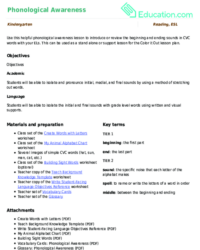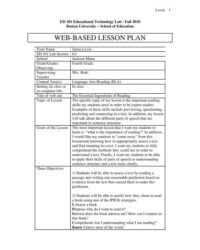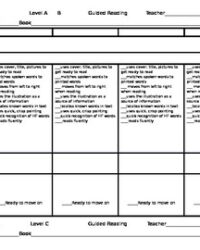Unlocking the mysteries of reading often begins with a fundamental skill that many early learners need to master: phonemic awareness. This isn’t just about knowing letters or sounds; it’s the ability to hear, identify, and manipulate individual sounds, or phonemes, in spoken words. It’s a powerful predictor of reading success, and for educators, having a structured approach to teaching these vital skills is absolutely essential.
That’s where a well-crafted phonemic awareness lesson plan template comes into play. It provides a clear roadmap, ensuring that every session is purposeful, engaging, and effectively builds the foundational auditory skills necessary for children to become confident readers. Let’s explore what makes these lessons so crucial and how a template can transform your teaching.
Understanding the Core of Phonemic Awareness Instruction
Phonemic awareness is a specific subset of phonological awareness, focusing on the smallest units of sound in language – phonemes. It’s an auditory skill, meaning it doesn’t involve print at all. Think about it: a child can be phonemically aware even if they don’t know a single letter of the alphabet. This skill is critical because it directly supports decoding, which is the ability to sound out words, and encoding, which is spelling. Without the ability to distinguish individual sounds, blending them to read or segmenting them to spell becomes incredibly difficult.
The development of phonemic awareness progresses through various stages, from simpler tasks like rhyming and alliteration to more complex manipulations. Early on, children might learn to identify and produce rhymes, recognizing that “cat” and “hat” sound similar. As their skills grow, they move into tasks like blending individual sounds to form a word (e.g., /c/ /a/ /t/ makes “cat”) or segmenting a word into its individual sounds. These are the building blocks upon which all future literacy skills are built.
What makes teaching phonemic awareness so impactful is its direct correlation with reading acquisition. Research consistently shows that strong phonemic awareness is one of the most powerful predictors of early reading success. Children who struggle with this skill often face significant challenges when learning to read and spell. Therefore, explicit and systematic instruction in these areas is non-negotiable for anyone looking to support young learners on their literacy journey.
Effective instruction in this area is often brief, focused, and fun, typically incorporated into daily routines. It’s about providing consistent exposure and opportunities for practice. A well-designed lesson acknowledges the progression of these skills and offers activities that match the developmental level of the learners, moving from simple sound play to more intricate sound manipulation.
Key Phonemic Awareness Skills to Teach
There’s a natural progression to how phonemic awareness skills develop. Here are some of the key areas typically addressed in lessons:
- Rhyming: Identifying and producing words that rhyme (e.g., “star” and “car”).
- Alliteration: Recognizing words that start with the same sound (e.g., “bouncing balls”).
- Syllable Blending and Segmenting: Combining parts of a word to say the whole word (e.g., “cup-cake” makes “cupcake”) or breaking a word into its syllables (e.g., “but-ter-fly”).
- Onset and Rime: Breaking a single syllable word into its initial consonant sound (onset) and the rest of the word (rime) (e.g., “c-at”).
- Phoneme Blending: Combining individual phonemes to say a word (e.g., /d/ /o/ /g/ makes “dog”).
- Phoneme Segmenting: Breaking a word into its individual phonemes (e.g., “dog” is /d/ /o/ /g/).
- Phoneme Manipulation: Adding, deleting, or substituting phonemes within words (e.g., changing /c/ in “cat” to /b/ makes “bat”).
Crafting Your Effective Lesson Plan
Developing a solid phonemic awareness lesson plan template is about more than just filling in blanks; it’s about creating a structured, flexible tool that empowers educators to deliver high-impact instruction. Such a template ensures that you cover all the necessary components of an effective lesson, from clear objectives to thoughtful assessment. It serves as a guide, helping you stay organized and ensuring consistency, whether you’re teaching a whole class or working with small groups.
A comprehensive template typically begins with identifying the specific phonemic awareness skill you plan to target. Is it phoneme blending, segmentation, or perhaps identifying initial sounds? Defining this clearly helps you select appropriate activities and materials. Following that, you’ll outline your learning objectives – what will students be able to do by the end of the lesson? These objectives should be measurable, so you can clearly see if students have grasped the concept.
Beyond objectives, a robust template includes sections for materials, a step-by-step procedure, differentiation strategies, and assessment. The procedure section is crucial; it breaks down the lesson into manageable parts, often including a warm-up, explicit instruction, guided practice, and independent practice. This structured approach helps students gradually build confidence and mastery. A great phonemic awareness lesson plan template also prompts you to think about how you’ll adapt the lesson for learners who need more support or those who are ready for a greater challenge, making it a truly versatile resource.
Essential Components of a Phonemic Awareness Lesson Plan Template
When designing or selecting a template, look for these key elements:
- Lesson Title & Skill Focus: Clearly states the specific phonemic awareness skill being addressed.
- Learning Objectives: What students will know or be able to do by the end of the lesson.
- Materials: A list of any manipulatives, visuals, or printables needed.
- Introduction/Warm-up: An engaging activity to review prior learning or introduce the concept.
- Explicit Instruction: Direct teaching of the new skill with clear explanations and modeling.
- Guided Practice: Opportunities for students to practice the skill with teacher support.
- Independent Practice: Activities for students to apply the skill on their own.
- Differentiation: Strategies for supporting struggling learners and challenging advanced learners.
- Assessment: How you will measure student understanding and progress.
- Reflection: A space for notes on what worked well and what could be improved for next time.
By thoughtfully planning each session and utilizing a well-designed template, educators can provide consistent, targeted instruction that builds essential auditory skills. This systematic approach not only supports literacy development but also instills confidence in young learners as they embark on their reading journey. It’s about laying a strong, sound foundation that will serve them well for years to come.


